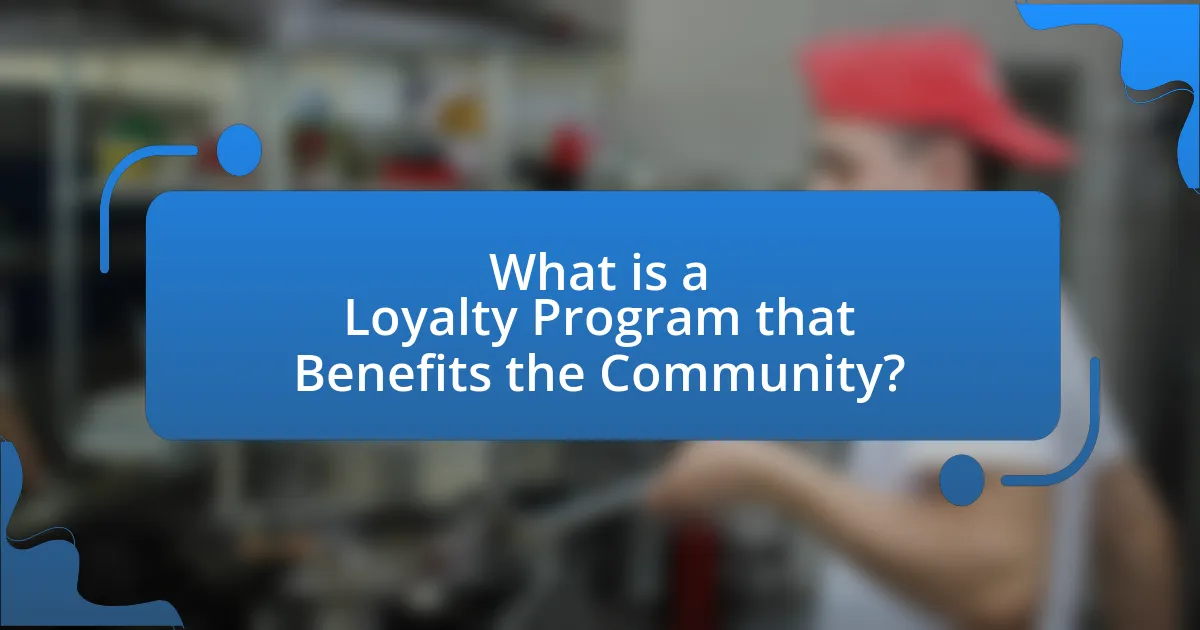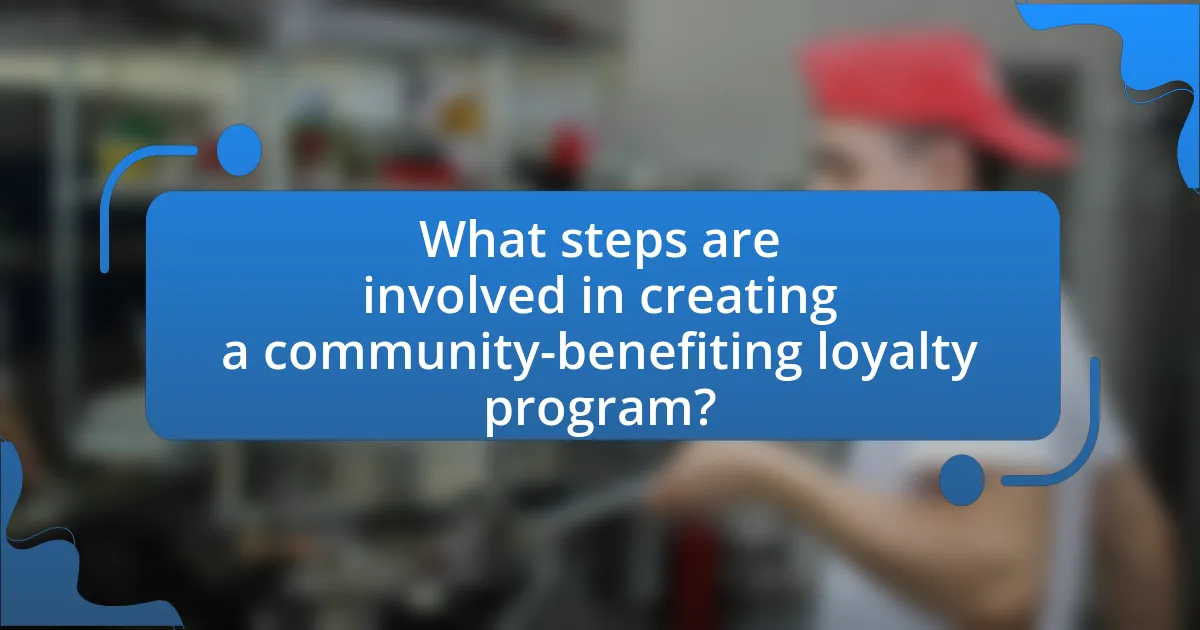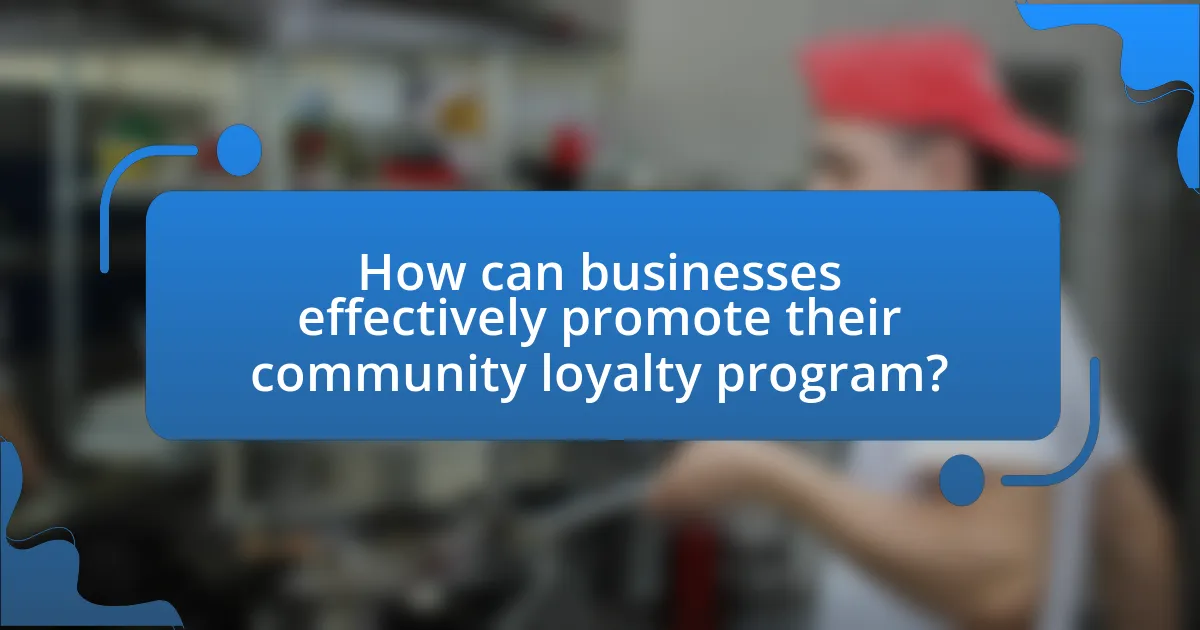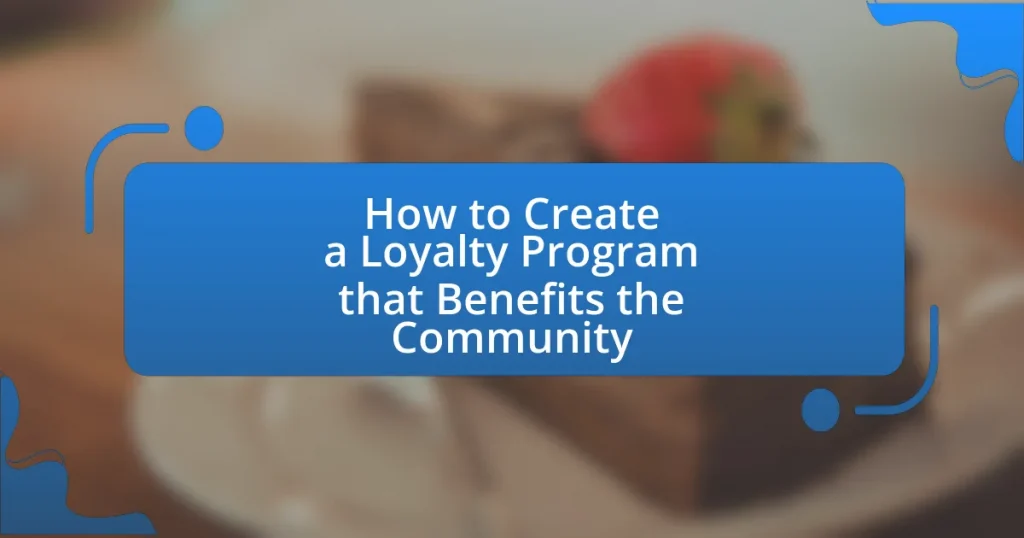A loyalty program that benefits the community is a structured initiative where businesses reward customers for their repeat patronage while contributing to local causes. This article outlines the differences between community-focused loyalty programs and traditional ones, emphasizing local engagement and social impact. Key elements include local partnerships, community engagement, and personalized experiences, all designed to align with community values. The article also discusses the importance of creating such programs for enhancing customer loyalty, driving sales, and fostering community ties, along with practical steps for implementation, methods for gathering feedback, and strategies for maintaining engagement over time.

What is a Loyalty Program that Benefits the Community?
A loyalty program that benefits the community is a structured initiative by businesses that rewards customers for their repeat patronage while simultaneously contributing to local causes or organizations. These programs often involve partnerships with local charities, where a portion of sales or points earned by customers is donated to community projects, schools, or non-profits. For example, a coffee shop might donate a percentage of every purchase made by loyalty members to a local food bank, thereby fostering community support and engagement. Such programs not only enhance customer loyalty but also promote social responsibility, creating a positive impact on the community.
How does a community-focused loyalty program differ from traditional loyalty programs?
A community-focused loyalty program differs from traditional loyalty programs primarily by emphasizing local engagement and social impact over individual rewards. Traditional loyalty programs typically prioritize customer retention through points, discounts, or exclusive offers, focusing on transactional benefits. In contrast, community-focused programs encourage customers to support local initiatives, charities, or businesses, fostering a sense of belonging and collective benefit. For example, a community loyalty program might donate a portion of sales to local schools or organize community events, directly linking customer participation to positive social outcomes. This approach not only enhances customer loyalty but also strengthens community ties, as evidenced by studies showing that businesses engaged in community support see increased customer loyalty and brand advocacy.
What are the key elements of a community-oriented loyalty program?
The key elements of a community-oriented loyalty program include local partnerships, community engagement, rewards for social impact, and personalized experiences. Local partnerships involve collaborating with nearby businesses and organizations to create a network that benefits both the program and the community. Community engagement focuses on involving members in local events and initiatives, fostering a sense of belonging. Rewards for social impact incentivize customers to participate in community service or sustainability efforts, reinforcing positive behaviors. Personalized experiences cater to individual preferences, enhancing customer satisfaction and loyalty. These elements collectively strengthen community ties and promote a shared sense of purpose.
How do community values influence the design of a loyalty program?
Community values significantly influence the design of a loyalty program by shaping its structure, rewards, and engagement strategies to align with the interests and priorities of the community. For instance, a loyalty program that emphasizes sustainability may offer rewards for eco-friendly purchases, reflecting the community’s commitment to environmental stewardship. Research indicates that programs designed with community values in mind can enhance customer loyalty and participation; a study by the Harvard Business Review found that businesses integrating social responsibility into their loyalty programs saw a 20% increase in customer retention. This alignment fosters a sense of belonging and encourages community members to engage more actively with the brand, ultimately driving both customer satisfaction and business success.
Why is it important to create a loyalty program that benefits the community?
Creating a loyalty program that benefits the community is important because it fosters a sense of belonging and encourages local engagement. When businesses implement such programs, they not only reward customers but also contribute to local initiatives, enhancing community well-being. For instance, a study by the American Express OPEN Small Business Monitor found that 70% of consumers prefer to support businesses that give back to their communities. This demonstrates that loyalty programs aligned with community benefits can increase customer retention and drive sales while simultaneously improving the social fabric of the area.
What impact does a community loyalty program have on local businesses?
A community loyalty program positively impacts local businesses by increasing customer retention and driving sales. These programs incentivize repeat purchases, fostering a sense of belonging among customers who feel connected to their community. For instance, a study by the Local Economy Project found that businesses participating in loyalty programs experienced a 20% increase in repeat customers, which directly correlates with higher revenue. Additionally, community loyalty programs often encourage customers to support local businesses over larger chains, enhancing the local economy and promoting sustainable practices.
How does a loyalty program foster community engagement and support?
A loyalty program fosters community engagement and support by incentivizing customers to participate in local events and initiatives. These programs often offer rewards for shopping at local businesses, which encourages consumers to support their community. For example, a study by the American Express OPEN Small Business Saturday Consumer Insights Survey found that 67% of consumers believe supporting local businesses is important, and loyalty programs can amplify this sentiment by providing tangible benefits for doing so. Additionally, loyalty programs can create a sense of belonging among members, as they often include exclusive access to community events, fostering deeper connections between businesses and their customers.

What steps are involved in creating a community-benefiting loyalty program?
Creating a community-benefiting loyalty program involves several key steps. First, identify the community’s needs and values through surveys or focus groups to ensure the program aligns with local interests. Next, design the program structure, including rewards that support local businesses or initiatives, such as discounts at community shops or donations to local charities for each purchase. Then, establish partnerships with local businesses to enhance the program’s offerings and create a network of support. After that, implement a marketing strategy to promote the program, utilizing social media and local events to reach potential participants. Finally, regularly evaluate the program’s impact on the community and make adjustments based on feedback to ensure it continues to meet community needs effectively.
How can businesses identify the needs of their community for a loyalty program?
Businesses can identify the needs of their community for a loyalty program by conducting surveys and engaging in direct conversations with customers. Surveys can provide quantitative data on customer preferences, while conversations can yield qualitative insights into community values and expectations. Research indicates that 70% of consumers prefer brands that listen to their feedback, highlighting the importance of customer engagement in program development. Additionally, analyzing purchasing patterns and local market trends can further inform businesses about what incentives would resonate most with their community.
What methods can be used to gather community feedback?
Surveys and questionnaires are effective methods to gather community feedback. These tools allow organizations to collect quantitative and qualitative data from community members regarding their preferences, experiences, and suggestions. According to a study by the Pew Research Center, 70% of respondents prefer online surveys for providing feedback, highlighting their convenience and accessibility. Additionally, focus groups facilitate in-depth discussions, enabling participants to express their thoughts and feelings about a loyalty program, which can yield rich insights. Social media platforms also serve as valuable channels for real-time feedback, as they allow community members to share their opinions and engage in discussions.
How can businesses align their loyalty program with community interests?
Businesses can align their loyalty programs with community interests by integrating local causes and initiatives into their rewards structure. For instance, companies can offer points or discounts for customers who participate in community service events or support local charities, thereby fostering a sense of community engagement. Research indicates that 70% of consumers prefer brands that support social causes, highlighting the effectiveness of this approach in enhancing customer loyalty while benefiting the community.
What are the best practices for designing a successful loyalty program?
The best practices for designing a successful loyalty program include creating clear and attainable rewards, personalizing the customer experience, and ensuring ease of use. Clear and attainable rewards motivate customers to engage with the program, as evidenced by a study from Bond Brand Loyalty, which found that 79% of consumers are more likely to engage with a loyalty program that offers easily achievable rewards. Personalization enhances customer satisfaction and retention; research by Epsilon indicates that 80% of consumers are more likely to make a purchase when brands offer personalized experiences. Lastly, ensuring ease of use, such as simple enrollment processes and straightforward redemption methods, is crucial, as 70% of customers abandon loyalty programs due to complexity, according to a report by Accenture.
How can businesses ensure inclusivity in their loyalty programs?
Businesses can ensure inclusivity in their loyalty programs by designing rewards that cater to diverse customer needs and preferences. This involves conducting market research to understand the demographics of their customer base, including age, gender, ethnicity, and socioeconomic status. By offering a variety of rewards that appeal to different groups, such as discounts, exclusive experiences, or community-focused initiatives, businesses can engage a broader audience.
Additionally, implementing accessible technology and communication methods, such as mobile apps that accommodate various languages and disabilities, further enhances inclusivity. According to a study by the American Marketing Association, inclusive marketing strategies can increase customer loyalty by up to 30%, demonstrating the effectiveness of these approaches in fostering a sense of belonging among customers.
What types of rewards are most appealing to community members?
Community members are most appealed by rewards that offer tangible benefits, such as discounts, exclusive access, and recognition. Discounts on products or services provide immediate financial incentives, while exclusive access to events or content fosters a sense of belonging and privilege. Recognition, such as featuring members in newsletters or social media, enhances their status within the community. Research indicates that 70% of consumers are more likely to recommend a brand with a good loyalty program, highlighting the effectiveness of these reward types in fostering engagement and loyalty.

How can businesses effectively promote their community loyalty program?
Businesses can effectively promote their community loyalty program by leveraging local partnerships and targeted marketing strategies. Collaborating with local organizations, such as schools or charities, can enhance visibility and credibility, as these partnerships often resonate with community values. Additionally, utilizing social media platforms to share success stories and testimonials from program participants can engage potential members and foster a sense of community. Research indicates that 70% of consumers are more likely to support businesses that contribute to local causes, highlighting the importance of aligning the loyalty program with community interests. Furthermore, offering exclusive rewards or discounts for community events can incentivize participation and strengthen customer relationships.
What marketing strategies work best for community loyalty programs?
Effective marketing strategies for community loyalty programs include personalized communication, community engagement initiatives, and rewards that resonate with local values. Personalized communication fosters a sense of belonging and connection, as studies show that 80% of consumers are more likely to engage with brands that offer personalized experiences. Community engagement initiatives, such as local events or partnerships with local businesses, enhance visibility and strengthen community ties, leading to increased participation in loyalty programs. Additionally, offering rewards that reflect local culture or needs, such as discounts at nearby shops or donations to local charities, can significantly boost program appeal, as 70% of consumers prefer brands that support their community. These strategies collectively enhance customer retention and loyalty within the community.
How can social media be leveraged to promote a loyalty program?
Social media can be leveraged to promote a loyalty program by creating engaging content that highlights the benefits and rewards of the program. For instance, brands can share testimonials from satisfied customers, showcase exclusive offers, and run targeted ads to reach potential members. According to a study by Sprout Social, 70% of consumers are more likely to engage with a brand that responds to their social media posts, indicating that active engagement can enhance visibility and participation in loyalty programs. Additionally, utilizing user-generated content, such as photos or reviews from loyal customers, can foster community and encourage others to join the program.
What role do partnerships with local organizations play in promotion?
Partnerships with local organizations play a crucial role in promotion by enhancing credibility and expanding reach within the community. These collaborations allow businesses to leverage the established trust and networks of local organizations, which can lead to increased visibility and engagement with potential customers. For instance, a study by the Local Initiatives Support Corporation found that businesses partnering with community organizations saw a 30% increase in customer engagement compared to those that did not. This demonstrates that such partnerships not only foster goodwill but also drive promotional effectiveness through shared resources and mutual support.
How can businesses measure the success of their community loyalty program?
Businesses can measure the success of their community loyalty program through key performance indicators (KPIs) such as customer retention rates, engagement levels, and redemption rates of rewards. Customer retention rates indicate how many customers continue to participate in the program over time, reflecting its effectiveness in fostering loyalty. Engagement levels can be assessed through metrics like participation in community events or interactions on social media, which show how actively customers are involved. Redemption rates of rewards provide insight into the attractiveness and perceived value of the program, as higher redemption rates suggest that customers find the rewards worthwhile. According to a study by Bond Brand Loyalty, 79% of consumers are more likely to continue doing business with brands that have a loyalty program, highlighting the importance of these metrics in evaluating program success.
What key performance indicators should be tracked?
Key performance indicators (KPIs) that should be tracked for a loyalty program include customer retention rate, average transaction value, frequency of purchases, and customer lifetime value. Customer retention rate measures the percentage of customers who continue to engage with the program over time, indicating loyalty. Average transaction value reflects the average amount spent per transaction, which can show the effectiveness of the program in encouraging higher spending. Frequency of purchases tracks how often customers make purchases, providing insight into engagement levels. Customer lifetime value estimates the total revenue a business can expect from a customer throughout their relationship, highlighting the long-term benefits of the loyalty program. These KPIs provide a comprehensive view of the program’s performance and its impact on community engagement.
How can customer feedback be utilized to improve the program?
Customer feedback can be utilized to improve the program by systematically collecting and analyzing insights from participants to identify areas for enhancement. This process allows program managers to understand customer preferences, pain points, and suggestions, which can lead to targeted adjustments that increase satisfaction and engagement. For instance, a study by the Harvard Business Review found that companies that actively seek and respond to customer feedback can see a 10-15% increase in customer retention rates. By implementing changes based on this feedback, such as adjusting reward structures or enhancing communication, the program can better align with community needs and expectations.
What are some common challenges in creating a community loyalty program?
Common challenges in creating a community loyalty program include defining clear objectives, engaging community members, and ensuring sustainable rewards. Defining clear objectives is crucial as it guides the program’s structure and goals; without this clarity, the program may lack direction and fail to resonate with participants. Engaging community members poses a challenge because it requires understanding their needs and preferences, which can vary widely. Ensuring sustainable rewards is also difficult, as businesses must balance offering attractive incentives while maintaining profitability. According to a study by the Loyalty Research Center, 70% of loyalty programs fail due to poor engagement and unclear objectives, highlighting the importance of addressing these challenges effectively.
How can businesses overcome resistance from customers or stakeholders?
Businesses can overcome resistance from customers or stakeholders by actively engaging them in the decision-making process and demonstrating the value of proposed changes. By involving customers and stakeholders through surveys, focus groups, or community meetings, businesses can gather feedback and address concerns directly, fostering a sense of ownership and collaboration. Research shows that companies that prioritize stakeholder engagement experience higher levels of trust and satisfaction, which can lead to increased loyalty and support for new initiatives. For instance, a study by the Harvard Business Review found that organizations that effectively communicate the benefits of their programs see a 30% increase in stakeholder buy-in.
What strategies can be implemented to maintain program engagement over time?
To maintain program engagement over time, implementing personalized communication strategies is essential. Tailoring messages based on customer preferences and behaviors increases relevance and fosters a deeper connection. For instance, a study by McKinsey & Company found that personalized experiences can lead to a 10-30% increase in customer engagement. Additionally, regularly updating program benefits and introducing gamification elements, such as rewards for participation, can sustain interest and motivate ongoing involvement. Research from the Journal of Marketing indicates that gamification can enhance user engagement by up to 48%. These strategies collectively ensure that participants remain actively engaged with the loyalty program over time.
What are the top tips for launching a successful community loyalty program?
To launch a successful community loyalty program, focus on clear objectives, engaging rewards, and effective communication. Establish specific goals that align with community values, such as increasing participation or fostering local partnerships. Offer rewards that resonate with community members, such as discounts at local businesses or exclusive access to events, which can enhance member engagement. Additionally, maintain open lines of communication through regular updates and feedback channels to ensure members feel valued and involved. Research indicates that programs with personalized rewards see a 20% increase in member retention, highlighting the importance of tailored incentives.


